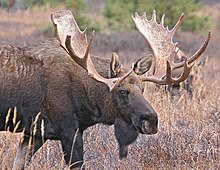This article needs additional citations for verification. (December 2016) |
| Alaska moose | |
|---|---|

| |
| Scientific classification | |
| Domain: | Eukaryota |
| Kingdom: | Animalia |
| Phylum: | Chordata |
| Class: | Mammalia |
| Order: | Artiodactyla |
| Family: | Cervidae |
| Subfamily: | Capreolinae |
| Genus: | Alces |
| Species: | |
| Subspecies: | A. a. gigas
|
| Trinomial name | |
| Alces alces gigas Miller, 1899
| |
The Alaska moose (Alces alces gigas), or Alaskan moose in Alaska, or giant moose and Yukon moose in Canada, is a subspecies of moose that ranges from Alaska to western Yukon. The Alaska moose is the largest subspecies of moose.[1] Alaska moose inhabit boreal forests and mixed deciduous forests throughout most of Alaska and most of Western Yukon. Like all moose subspecies, the Alaska moose is usually solitary but sometimes will form small herds. Typically, they only come into contact with other moose for mating or competition for mates. Males and females select different home ranges during different seasons. This leads to spatial segregation throughout much of the year. While males and females are spatially separate the habitat that they occupy is not significantly different.[2] During mating season, in autumn and winter, male Alaska moose become very aggressive and prone to attacking when startled.
- ^ Long, Nancy; Savikko, Kurt (August 7, 2009). "Moose: Wildlife Notebook Series – Alaska Department of Fish and Game". Adfg.state.ak.us. Archived from the original on November 30, 2009. Retrieved November 27, 2009.
- ^ Oehlers, Susan A.; Bowyer, R. Terry; Huettmann, Falk; Person, David K.; Kessler, Winifred B. (2011). "Sex and scale: implications for habitat selection by Alaskan mooseAlces alces gigas". Wildlife Biology. 17 (1): 67–84. doi:10.2981/10-039. ISSN 0909-6396. S2CID 86133235.[permanent dead link]
